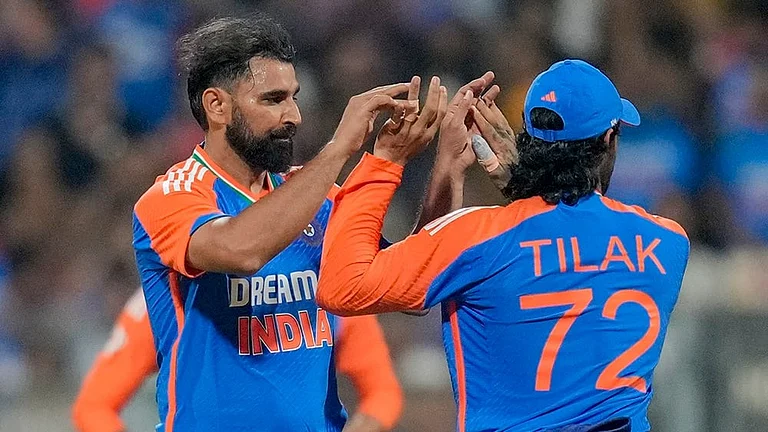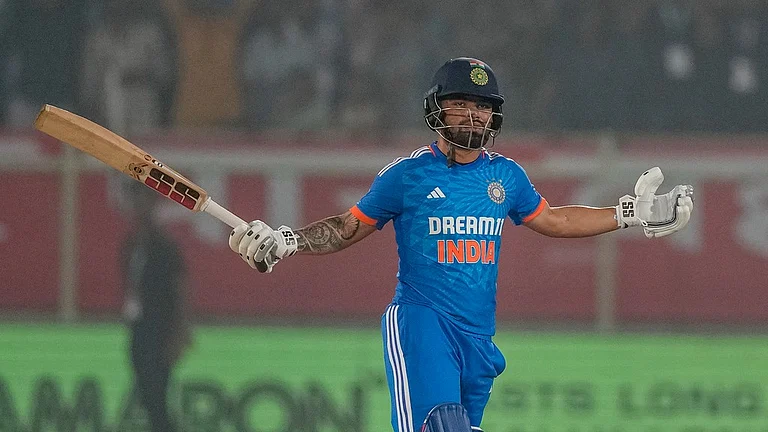(Love is our deepest value: Love is freedom, love is salvation. If love tears us apart, it also keeps us alive. No matter what, love finds a way, almost always. Going against the grimy grain of contemporary political discourse, we have declared 2022 to be the year of love: for us, talking about love in a time of hatred is a revolutionary act. Outlook's first issue of the year revisited The Beatles’ words of wisdom: “All We Need Is Love.” It didn't stop there: we will publish love stories all year long. The next full moon, which falls on February 16, is all set to put under the spotlight our passions, our romantic quests. On Valentine’s Day, we feature a curated selection of love stories that will tug at your heartstrings.)
As soon as the clock struck 12, Ankit (name changed) pressed the share button on his phone. In a few seconds, all his friends on the other end of Instagram, now knew how much he loved and missed his partner, his girlfriend, his Valentine.
“I miss you. Hope to see you soon My Valentine,” he writes on a throwback slow-mo video of his partner flipping her hair in the wind and looking at him with a loving gaze.
Stationed in a different city than his partner, he’s gone the extra mile to ensure that his feelings are conveyed perfectly and added the tunes of Ed Sheeran’s “Perfect” in the backdrop.
February 14 is celebrated as a day for couples to declare their love for each other, but why is it important for the world to see the love that is meant to be shared between the two of them? Why does romance that is supposed to be a very intimate and personal emotion, require a public exhibition?
Ankit could have simply professed his love over a personal call to his partner — the only person who really matters in this equation, and he did. Then, why this need for an additional public declaration?
He says it is just one of the many ways to make his partner feel special and celebrate their love with the world.
Ankit says, “Through a social expression of love you let the world know how important this other person is to you. And in the process it also makes your partner feel more confident about the relationship.”
A 2020 study that looked at people’s need for “showing off” their relationships on social media said that the action was often motivated by a need to feel more connected to their partners, and to announce to the world (repeatedly) that they were taken.
The study hinted that it was a way for couples to reassure themselves and the world of the romantic stability in their relationship. It is for the same reason, perhaps that individuals make their relationship status on Facebook public, and if it is not, a quick scroll through an individual’s profile is enough to figure that out.

The expression of love on social media is a year-round phenomenon, but there are a few days when the romantic quotient goes a notch higher than usual. It’s the special occasions - birthdays, anniversaries, and the day of love itself — Valentine’s Day.
The reason people try to showcase their relationships and more so on special days like Valentine's Day is the “need for acceptance and the need for people to know that they are in a happy relationship”.
Says psychotherapist Padma Rewari, “Scientifically it’s the hormones such as dopamine and oxytocin which trigger the need for acceptance, popularity and building on self-esteem.”
She explains that in a world dominated by social media, it was natural for people to seek approval for themselves and their relationships through the medium and that there was “no harm” in sharing warm photos of a couple’s time spent together.
American writer Susan Sontag in her 1977 book “On Photography” had said, “today, everything exists to end in a photograph”.
Over four decades later, social media has emerged as a medium of creating a repository of memories, a digital version, one might say, of what once used to be a photo album.
And while a pop-up notification about a Facebook memory of a cherished moment from a forgotten trip from several years back evokes a kind of nostalgia similar to one triggered by the crinkly flipping of plastic pages of a photo album, these memories are also up for being viewed, critiqued, scrutinised and validated by a community of online “friends”.
Professing love over social media has become an integral part of contemporary romance paraphernalia, even if the person you love is sitting right next to you.
Naina (name changed) posted a romantic selfie of her with her partner, and captioned the picture with the most memorable dialogue from the Julia Roberts-Hugh Grant romantic comedy, “Notting Hill”.
“I’m just a girl, standing in front of a boy, asking him to love her."
But the declaration of love isn’t complete unless it is on social media. You can have the most loving of the relationships, and spend a gloriously romantic evening complete with the cliched candlelight dinner, and slow dancing to “love the way you look tonight”, but it doesn’t seem real until it is on social media, being validated by likes and hearts being shared by friends, acquaintances and strangers.
A perfectly planned date today could go horribly wrong if your phone does not have enough battery to document all of it.
If there’s not enough proof of the event in your photo gallery, did the date even happen?
On Valentine’s Day, social media faces a surge of couple pictures, of cosying up together, or sharing a memory from an important moment in their lives together or from the trip they took to celebrate the day, superimposed with filters of doodling hearts, and roses.
Some couples share what their partners have gifted them on this special day of love — chocolates, roses, a diamond ring, a watch or a car.
Soumita (name changed) shared a picture with her husband, both dressed up in a beautifully lit room. In the background is a framed photograph of the couple from their wedding day.
Whether the captionless post is a fresh or a throwback image is not clear, but it sure is a virtual testimony of their “forever love”.
When this memory pops up on Facebook two years later, they will be reminded of this Valentine’s Day, and strive to live up to it, or even make it grander, and then post about it to let the world know how their love is still going strong.
Vicious or not, it is a cycle that has caught the fancy of even the most reasonable of individuals.
For couples who have been together for a long time, public display of affection is a way of “chasing a reverse mechanism of self rationalization” aimed at making themselves believe that everything is hunky-dory in their relationship, says Rewari.
In such cases, while there seems to be an expression of love for the world to see, couples often ignore the work that needs to be done on the relationship in the real world, between the two partners.
She explains, “Posting every minute of your personal and private life is not normal… couples have forgotten how to enjoy the ‘couple moment’.
“How much time you spend on social media can change the dynamics of a relationship, and it may supersede the real relationship goals.”
There is something called the psychology of social media and how it can influence people is not unknown.
Often the need for public display of affection stems not so much from love, but to establish and quantify the existence of love in one’s life.
In the week leading up to February 14, Mehak (name changed) was gifted a three-part Valentine’s Day gift by her husband — a pair of diamond earrings, the latest iPhone and a romantic trip to Goa, a fact she shared with her 1300 followers on Instagram.
“Focus is more external to prove something to the loved one and others. In many cases it is to show off the presents and gifts or flowers, telling the world that ‘I can afford this’. It’s mostly to feel validated against an otherwise strong internal negative belief, ‘I am not good enough’,” says psychologist Dr Seema Hingorrani.
Seeking validation through public display of affection is most likely a strategy of the human mind to convince itself that the life that is otherwise full of challenges, is perfect. But Rewari says that it was important for couples to distinguish between the “personal from the public”. It is conspicuous that while a large number of likes and comments on social media can have a positive impact on one’s confidence levels, the lack of virtual adulation can also have an adverse effect.
It was to control the social media-induced anxiety that Instagram came out with an option to hide the number of likes that someone's post receives.
The photo-sharing application in 2016 had said that it wanted to create a safe space for users who could feel free to post content of their choice without feeling the pressure of receiving an acceptable number of likes on their posts.
Rewari adds, “Today we have multiple social media platforms and these platforms will increase in numbers with time. How are we going to safeguard ourselves emotionally and rely on external sources for solace? It is time to act and reflect.”
A code of conduct and being mindful will help a long way in handling social media in a sensible way, she says.


























